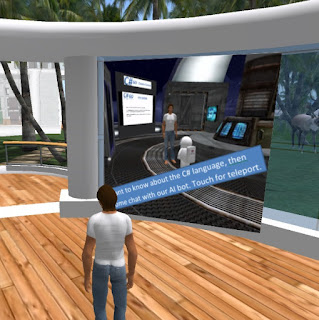My virtual
world project for level 5 students was named Carbon Free, so no real surprises
on what is likely to be required here. The project requirement is to create a
desk to application written in Java that will simulate the electrical
consumption of a small residence that is powered from renewables. As with the presentation of all my virtual
world projects the purpose for me is to see how the environment can be
structured and presented in such a way that it produced a viable pedagogical ly
sound solution. As with earlier ventures I have made use of Note boards
notecards, interactive simulations and activity logging to a MySQL database.
On arrival a
series of four numbered note boards explain the task and how to proceed with
the simulations; note rotating carbon molecule was purely aesthetic.
At this
point students are made aware that there are five renewable energy types hey need to understand and these are:- Water turbine, wind turbines,
Solar cells, solar collectors and wood burning stoves, though this last
category seems to have dropped from inclusion recently. While each of the
builds is powered by a combination of renewable energy resources, there will be
a particular notecard based tutorial accessed through a picture in each of the
builds.
The image here shows the eco warrior’s solar pod; as with all the builds you can purchase
scripted versions at Slmarketplace or free unscripted versions at Openworldz. The
pod is powered by a wind turbine, solar cells and a solar collector.
The screen shot below taken inside the pod shows a number of domestic appliances some of which are
switched on (green messages) while other are switched off (red messages); an
appliance can be switch on or off by simply touching.
On the wall
of the pod a power monitor can be touched on that will report on the
consumption of appliances, the power available and carbon saving and this is data
that students are able to use as a means of verifying their own simulated
results.
The
tutorial that can be accessed in the pod is for a wood burning stove shown in
the image here. Touching the picture will dispenses a note-card that explains the physics and then poses a question to be solved; each question has randomised values so students will receive a unique version.
Once the question on the postcard has been solved then the
postcard is dropped into a postbox outside each of the builds.
The virtual
world learning project ran for a week and the six participants clocked up close
on 600 transactions, a busy and as far as I can tell very successful time.
 Just uploaded my build of the project Mustard space plane to the outworldz server, so please feel free to download a copy for your virtual world project. Project MUSTARD (Multi-Unit Space Transport And Recovery Device) or MUSTARD, was a 1960’s design concept from the British Aircraft Corporation (BAC) able to place payloads of up to 5000lb (2,300 kg) into low earth orbit and stood some 118 feet (36 m) tall. The unique feature of the space plane was that each stage was piloted and so able to land on a runway and be used again. The project was finally cancelled however in 1970.
Just uploaded my build of the project Mustard space plane to the outworldz server, so please feel free to download a copy for your virtual world project. Project MUSTARD (Multi-Unit Space Transport And Recovery Device) or MUSTARD, was a 1960’s design concept from the British Aircraft Corporation (BAC) able to place payloads of up to 5000lb (2,300 kg) into low earth orbit and stood some 118 feet (36 m) tall. The unique feature of the space plane was that each stage was piloted and so able to land on a runway and be used again. The project was finally cancelled however in 1970.










